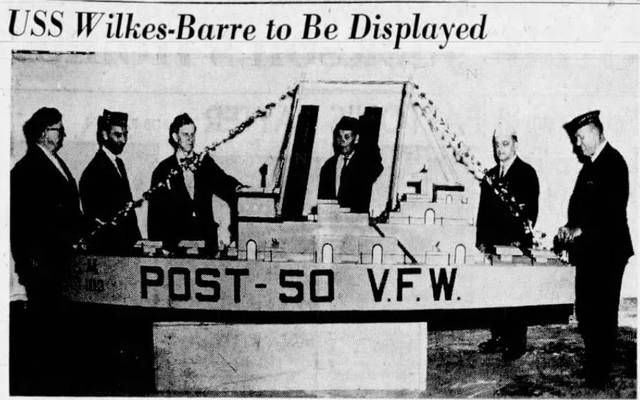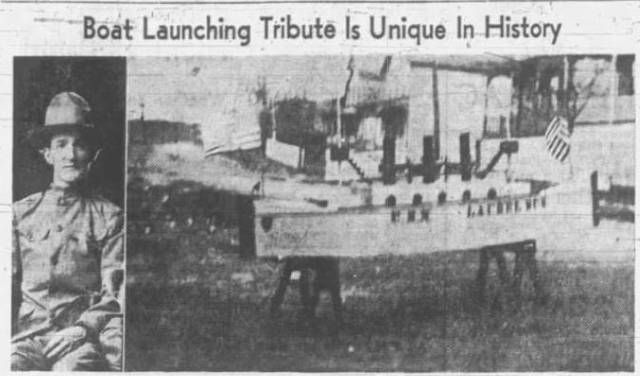
A replica of the U.S. Naval cruiser USS Wilkes-Barre before it was blown up on the Susquehanna River in 1969. Picture published in the Wilkes-Barre Record May 24, 1969.
Click here to subscribe today or Login.
A Memorial Day tradition for several decades that has since faded away was parading a replica of a U.S. Naval warship before blowing it up on the Susquehanna River.
What is credited as the first official flower-laden warship being demolished started in 1919 by the John J. Pershing Post 50, which was located on South Main Street in Wilkes-Barre. The tradition continued when Post 50 was renamed Capt. Christian E. Stegmaier, Veterans of Foreign Affairs, in August 1933, which moved to North Main Street.
A replica warship was covered with flowers placed by gold-star mothers or their daughters before being pulled by horses of the 109th Field Artillery in parades. The parade route would end on South River Street along the river common where the boat was placed in the Susquehanna River and exploded to honor fallen war heroes.
After World War II, Post 50 began using a replica of the U.S. Naval cruiser, the U.S.S. Wilkes-Barre, every year that was constructed and painted in latter years by students at West Side and Wilkes-Barre career and technology centers.
“Of all the ceremonies conducted throughout the Wyoming Valley in commemoration of the hero dead, on this important day, none are more unique and typical of cherished honor to the American veterans, of land and sea, than the launching of a miniature flower-laden boat, an annual custom, which was again observed this morning from the river common,” the Times Leader reported May 31, 1926.
“As the little craft was carried down stream, it was blown to atoms by a charge of dynamite placed in it, previous to launching, and ignited by a time fuse, and as the smoke cleared away, Taps was sounded by Sgt. Walter Price and John Newman, and the ceremonies concluded,” the Times Leader reported.
While Post 50 officially began sponsoring the replica warship event in 1919, the Times Leader on June 1, 1968, published a story about the very first explosion to honor fallen servicemen occurred in 1902.
“A local hero of the Spanish-American War, William P. Williams, who had served aboard the U.S.S. Indiana and was recipient of the Congressional Medal of Honor for valorous conduct in that war, has been generally credited with originating the idea of the launching,” the newspaper reported.
Williams constructed a cigar-box like boat and blew it up in the river.
A decade later, in 1912, the Times Leader reported a model of the Civil War iron clad warship, the Monitor, was set afloat in the river following the Memorial Day parade that year.
It wasn’t until 1919 when Post 50 began its annual tradition.
“First miniature battleship to be put into the Susquehanna River as a tribute to the heroes of past wars who have given their lives for their country was constructed by Harvey “Gus” Casterline,” the Times Leader reported June 1, 1968.
Casterline and his two sons built the first replica warship in the front yard of a home at 35 Marshall St., in Wilkes-Barre Township.
Casterline’s first replica was built “of white pine and was eight feet long. It had a deck 24 inches long and 18 inches high. it also had two smokestacks made of metal,” the Times Leader reported.
Original plans were to have the replica warship float down the Susquehanna River with hopes of entering the Chesapeake Bay and then into the Atlantic Ocean. It wasn’t until boys downstream towed the replica to shore.
“On another year, the boat floated almost to Harrisburg before it was again captured by persons fishing in a rowboat and this prompted the decision by Post 50 to blow up the boat in midstream after it had passed the reviewing stand set up on the river common,” the newspaper reported.
Sadly, the last replica U.S.S. Wilkes-Barre was blown up on Memorial Day in 1976.
“A traditional Memorial Day Ceremony which includes the blowing apart a replica of a ship in the Susquehanna River along the Wilkes-Barre River Common will not be held this year. The Pennsylvania Fish Commission is prohibiting the event,” the Times Leader reported May 10, 1977.
The Times Leader in the June 1, 1968, story referenced the first Memorial Day celebration and parade in the Wyoming Valley.
Widowers of Civil War veterans decorated their late husbands grave markers with flowers in 1868. The following year, 1869, Conyngham Post 97, Grand Army of the Republic, sponsored a parade that began at East Market Street and Public Square, traveling on several downtown streets before returning to Public Square for a concert.





